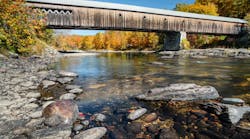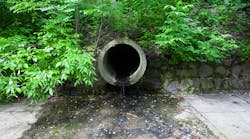Concluding this three-part series on stormwater and erosion control standards of professionalism, author Jerald S. Fifield further discusses concepts of professional integrity derived from an educated understanding of S&EC components and follow-up accountability toward project implementation. Despite a diversity of professional backgrounds—whether the credentials originate in engineering disciplines or the field of environmental sciences—professional certification, a thorough understanding of planning and regulatory requirements, as well as experience in stormwater and erosion control practices hold such professionals accountable.
Are Professional Engineers Qualified to Develop, Sign, and Review Sediment and Erosion Control Plans? (Part 3) By Jerald S. Fifield
Are Professional Engineers Qualified to Develop, Sign, and Review Sediment and Erosion Control Plans? (Part 3) By Jerald S. Fifield
[text_ad] Qualifying Sediment and Erosion Control Designers and Reviewers The previous discussions demonstrate that developing and reviewing S&EC plans is definitely not solely an engineering discipline. Nor is it confined to those working in forestry, hydrology, agronomy, geology, or any specific technical specialty. Few professionals are taught about construction-site sediment and erosion control while earning a higher education degree, because S&EC plan development and review is a composite of many technical and diverse disciplines. Designers and reviewers must be able to demonstrate accountability for their S&EC expertise. The best way to exhibit these skills is to obtain professional certification that they are qualified to develop, sign, and review S&EC plans based upon their experience, education, and an evaluation of their knowledge. Experience is one of the more important qualifications designers and reviewers must obtain. Before they regularly develop, sign, or review S&EC plans, it is suggested that designers and reviewers have at least one year of prequalified experience with 10-acre (4-hectare) or larger construction sites involving at least the following: • Assisting with developing and/or reviewing S&EC plans • Installing, maintaining, and removing BMPs • Conducting S&EC construction site inspections • Writing inspection and corrective action reports • Updating construction-site S&EC drawings Education is nearly as important as experience and is essential if one is to fully understand all aspects of sediment and erosion control. Few designers and reviewers learn about sediment and erosion control while earning a college degree, because such skills are usually acquired by post-college education. It is suggested designers and reviewers obtain comprehensive education on at least the following topics: • Requirements of rules and regulations (local and/or EPA) • Principles and practices of sediment and erosion control and pollution prevention • Assessing construction site conditions that impact stormwater quality • Incorporating modeling into the development of sediment and erosion control plans • Assessing the effectiveness and limitations of stormwater controls • Designing sediment containment systems (e.g., silt fence barriers, sediment ponds) • Understanding and incorporating erosion control practices • Conducting inspections and writing reports • Developing effective and practical S&EC drawings Evaluation is essential to demonstrate accountability. Passing a comprehensive and closed-book certification examination by at least 75% will provide an assessment of a designer’s and reviewer’s expertise on a variety of sediment and erosion control matters. Suggested topics for testing include the following: • Rules and regulations (no more than 20% of the questions) • Principles of sediment and erosion control and modeling (about 20% of the questions) • Assessing BMP design, effectiveness, and limitations (about 20% of the questions) • Conducting inspections (about 15% of the questions) • Developing effective and practical S&EC drawings (no more than 25% of the questions) Finally, organizations that test and certify sediment and erosion control professionals’ expertise must provide a comprehensive and practical assessment of each applicant’s proficiency while maintaining high professional standards. Only in this manner will a meaningful certification program exist. [text_ad] Summary Sediment and erosion control is not solely an engineering discipline nor confined to any one profession. Instead, development of S&EC plans and their accompanying drawings requires the expertise of many different professional skills, along with incorporating the knowledge of contractors and inspectors. The role of designers and reviewers is to ensure the development and review of S&EC plans includes a comprehensive narrative section as well as practical and effective drawings. Most importantly, development of the drawings must be done in a manner that permits contractors to implement sediment and erosion control measures in a cost-effective way that minimizes non-compliant conditions. Designers and reviewers should obtain certification that they are accountable to design, sign, and review S&EC plans and the accompanying drawings. Such certifications must be based upon experience, education, and testing as administered by organizations having high professional standards. References Fifield, Jerald S. 2011. Designing and Reviewing Effective Sediment and Erosion Control Plans. Santa Barbara, CA: Forester Media. Sheppard, Sherri, A. Colby, K. Macatangay, and W. Sullivan. 2006. “What is Engineering Practice?” International Journal of Engineering Education 22(3): 429–438. USEPA 2007. Developing Your Stormwater Pollution Prevention Plan, A Guide for Construction Sites. Environmental Protection Agency. Washington DC, May 2007. 50 pages. --- 2012. National Pollutant Discharge Elimination System, General Permit for Discharges from Construction Activities. Environmental Protection Agency. Washington DC, February 2012. 151 pages.Qualifying Sediment and Erosion Control Designers and Reviewers
The previous discussions demonstrate that developing and reviewing S&EC plans is definitely not solely an engineering discipline. Nor is it confined to those working in forestry, hydrology, agronomy, geology, or any specific technical specialty. Few professionals are taught about construction-site sediment and erosion control while earning a higher education degree, because S&EC plan development and review is a composite of many technical and diverse disciplines.
Designers and reviewers must be able to demonstrate accountability for their S&EC expertise. The best way to exhibit these skills is to obtain professional certification that they are qualified to develop, sign, and review S&EC plans based upon their experience, education, and an evaluation of their knowledge.
Experience is one of the more important qualifications designers and reviewers must obtain. Before they regularly develop, sign, or review S&EC plans, it is suggested that designers and reviewers have at least one year of prequalified experience with 10-acre (4-hectare) or larger construction sites involving at least the following:
• Assisting with developing and/or reviewing S&EC plans
• Installing, maintaining, and removing BMPs
• Conducting S&EC construction site inspections
• Writing inspection and corrective action reports
• Updating construction-site S&EC drawings
Education is nearly as important as experience and is essential if one is to fully understand all aspects of sediment and erosion control. Few designers and reviewers learn about sediment and erosion control while earning a college degree, because such skills are usually acquired by post-college education.
It is suggested designers and reviewers obtain comprehensive education on at least the following topics:
• Requirements of rules and regulations (local and/or EPA)
• Principles and practices of sediment and erosion control and pollution prevention
• Assessing construction site conditions that impact stormwater quality
• Incorporating modeling into the development of sediment and erosion control plans
• Assessing the effectiveness and limitations of stormwater controls
• Designing sediment containment systems (e.g., silt fence barriers, sediment ponds)
• Understanding and incorporating erosion control practices
• Conducting inspections and writing reports
• Developing effective and practical S&EC drawings
Evaluation is essential to demonstrate accountability. Passing a comprehensive and closed-book certification examination by at least 75% will provide an assessment of a designer’s and reviewer’s expertise on a variety of sediment and erosion control matters. Suggested topics for testing include the following:
• Rules and regulations (no more than 20% of the questions)
• Principles of sediment and erosion control and modeling (about 20% of the questions)
• Assessing BMP design, effectiveness, and limitations (about 20% of the questions)
• Conducting inspections (about 15% of the questions)
• Developing effective and practical S&EC drawings (no more than 25% of the questions)
Finally, organizations that test and certify sediment and erosion control professionals’ expertise must provide a comprehensive and practical assessment of each applicant’s proficiency while maintaining high professional standards. Only in this manner will a meaningful certification program exist.
Are Professional Engineers Qualified to Develop, Sign, and Review Sediment and Erosion Control Plans? (Part 3) By Jerald S. Fifield
[text_ad] Qualifying Sediment and Erosion Control Designers and Reviewers The previous discussions demonstrate that developing and reviewing S&EC plans is definitely not solely an engineering discipline. Nor is it confined to those working in forestry, hydrology, agronomy, geology, or any specific technical specialty. Few professionals are taught about construction-site sediment and erosion control while earning a higher education degree, because S&EC plan development and review is a composite of many technical and diverse disciplines. Designers and reviewers must be able to demonstrate accountability for their S&EC expertise. The best way to exhibit these skills is to obtain professional certification that they are qualified to develop, sign, and review S&EC plans based upon their experience, education, and an evaluation of their knowledge. Experience is one of the more important qualifications designers and reviewers must obtain. Before they regularly develop, sign, or review S&EC plans, it is suggested that designers and reviewers have at least one year of prequalified experience with 10-acre (4-hectare) or larger construction sites involving at least the following: • Assisting with developing and/or reviewing S&EC plans • Installing, maintaining, and removing BMPs • Conducting S&EC construction site inspections • Writing inspection and corrective action reports • Updating construction-site S&EC drawings Education is nearly as important as experience and is essential if one is to fully understand all aspects of sediment and erosion control. Few designers and reviewers learn about sediment and erosion control while earning a college degree, because such skills are usually acquired by post-college education. It is suggested designers and reviewers obtain comprehensive education on at least the following topics: • Requirements of rules and regulations (local and/or EPA) • Principles and practices of sediment and erosion control and pollution prevention • Assessing construction site conditions that impact stormwater quality • Incorporating modeling into the development of sediment and erosion control plans • Assessing the effectiveness and limitations of stormwater controls • Designing sediment containment systems (e.g., silt fence barriers, sediment ponds) • Understanding and incorporating erosion control practices • Conducting inspections and writing reports • Developing effective and practical S&EC drawings Evaluation is essential to demonstrate accountability. Passing a comprehensive and closed-book certification examination by at least 75% will provide an assessment of a designer’s and reviewer’s expertise on a variety of sediment and erosion control matters. Suggested topics for testing include the following: • Rules and regulations (no more than 20% of the questions) • Principles of sediment and erosion control and modeling (about 20% of the questions) • Assessing BMP design, effectiveness, and limitations (about 20% of the questions) • Conducting inspections (about 15% of the questions) • Developing effective and practical S&EC drawings (no more than 25% of the questions) Finally, organizations that test and certify sediment and erosion control professionals’ expertise must provide a comprehensive and practical assessment of each applicant’s proficiency while maintaining high professional standards. Only in this manner will a meaningful certification program exist. [text_ad] Summary Sediment and erosion control is not solely an engineering discipline nor confined to any one profession. Instead, development of S&EC plans and their accompanying drawings requires the expertise of many different professional skills, along with incorporating the knowledge of contractors and inspectors. The role of designers and reviewers is to ensure the development and review of S&EC plans includes a comprehensive narrative section as well as practical and effective drawings. Most importantly, development of the drawings must be done in a manner that permits contractors to implement sediment and erosion control measures in a cost-effective way that minimizes non-compliant conditions. Designers and reviewers should obtain certification that they are accountable to design, sign, and review S&EC plans and the accompanying drawings. Such certifications must be based upon experience, education, and testing as administered by organizations having high professional standards. References Fifield, Jerald S. 2011. Designing and Reviewing Effective Sediment and Erosion Control Plans. Santa Barbara, CA: Forester Media. Sheppard, Sherri, A. Colby, K. Macatangay, and W. Sullivan. 2006. “What is Engineering Practice?” International Journal of Engineering Education 22(3): 429–438. USEPA 2007. Developing Your Stormwater Pollution Prevention Plan, A Guide for Construction Sites. Environmental Protection Agency. Washington DC, May 2007. 50 pages. --- 2012. National Pollutant Discharge Elimination System, General Permit for Discharges from Construction Activities. Environmental Protection Agency. Washington DC, February 2012. 151 pages.Summary
Sediment and erosion control is not solely an engineering discipline nor confined to any one profession. Instead, development of S&EC plans and their accompanying drawings requires the expertise of many different professional skills, along with incorporating the knowledge of contractors and inspectors.
The role of designers and reviewers is to ensure the development and review of S&EC plans includes a comprehensive narrative section as well as practical and effective drawings. Most importantly, development of the drawings must be done in a manner that permits contractors to implement sediment and erosion control measures in a cost-effective way that minimizes non-compliant conditions.
Designers and reviewers should obtain certification that they are accountable to design, sign, and review S&EC plans and the accompanying drawings. Such certifications must be based upon experience, education, and testing as administered by organizations having high professional standards.
References
Fifield, Jerald S. 2011. Designing and Reviewing Effective Sediment and Erosion Control Plans. Santa Barbara, CA: Forester Media.
Sheppard, Sherri, A. Colby, K. Macatangay, and W. Sullivan. 2006. “What is Engineering Practice?” International Journal of Engineering Education 22(3): 429–438.
USEPA 2007. Developing Your Stormwater Pollution Prevention Plan, A Guide for Construction Sites. Environmental Protection Agency. Washington DC, May 2007. 50 pages.
— 2012. National Pollutant Discharge Elimination System, General Permit for Discharges from Construction Activities. Environmental Protection Agency. Washington DC, February 2012. 151 pages.






